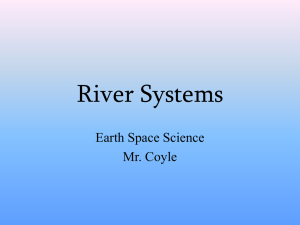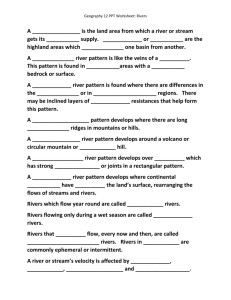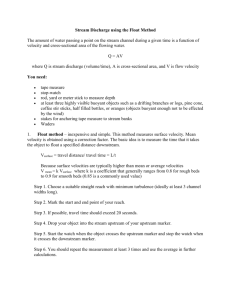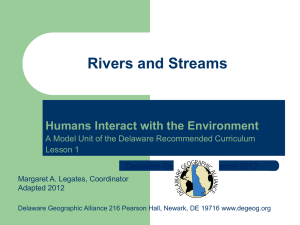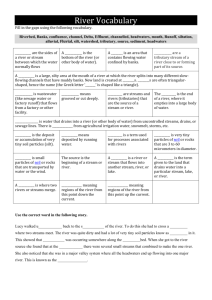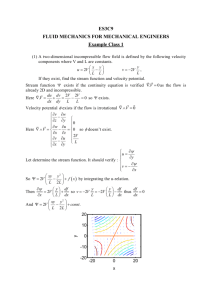3.1 Rivers - WordPress.com
advertisement
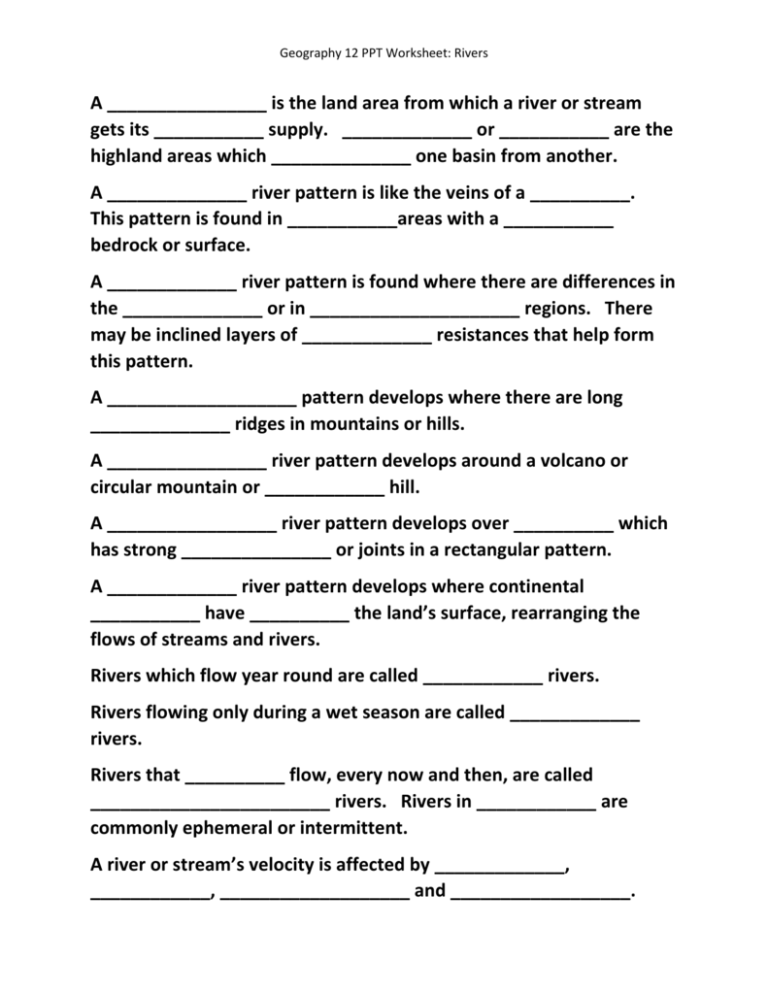
Geography 12 PPT Worksheet: Rivers A ________________ is the land area from which a river or stream gets its ___________ supply. _____________ or ___________ are the highland areas which ______________ one basin from another. A ______________ river pattern is like the veins of a __________. This pattern is found in ___________areas with a ___________ bedrock or surface. A _____________ river pattern is found where there are differences in the ______________ or in _____________________ regions. There may be inclined layers of _____________ resistances that help form this pattern. A ___________________ pattern develops where there are long ______________ ridges in mountains or hills. A ________________ river pattern develops around a volcano or circular mountain or ____________ hill. A _________________ river pattern develops over __________ which has strong _______________ or joints in a rectangular pattern. A _____________ river pattern develops where continental ___________ have __________ the land’s surface, rearranging the flows of streams and rivers. Rivers which flow year round are called ____________ rivers. Rivers flowing only during a wet season are called _____________ rivers. Rivers that __________ flow, every now and then, are called ________________________ rivers. Rivers in ____________ are commonly ephemeral or intermittent. A river or stream’s velocity is affected by _____________, ____________, ___________________ and __________________. Geography 12 PPT Worksheet: Rivers A stream’s _______________ refers to the ____________ of water flowing ______________(m3/s) that it carries. A stream’s velocity is __________________ to its discharge. The profile, _______________ or degree of ___________ of a stream affects its velocity with _______________ favouring _____________ velocities. Streams in _____________ have ____________ profiles while streams in ______________ have more __________ profiles. A stream typically flows ____________ near its mouth where it joins a lake or ocean. Since rivers generally flow faster ______________ than upstream, _______________ is not the only factor affecting stream velocity. The ______________ the channel of a stream, the ______________ its velocity which is _______________ by rough features slowing the flow. ____________ in a river channel and __________ along the bottom and sides of a channel _________ a river’s velocity. A mud bottom has less _____________ than a rocky bottom which helps to ________________ a river. A stream’s ________________ is the ratio of its cross-sectional area to its wetted perimeter. A ___________ hydraulic radius generally means ___________ friction which produces a ___________ flow and therefore _____________ velocity. The hydraulic radius is a measure of how ___________ a river flows. For two rivers with the ___________ cross-sectional area, a _______________ river has a _____________hydraulic radius which produces a _____________ velocity. This is because the river water has more contact with its channel which produces _______________, slowing the river down. Geography 12 PPT Worksheet: Rivers For a river with an even channel, the water ______________ in the ______________, near the ___________. In deeper places the flow is _____________ while in shallower places the flow is ___________ because there is ____________ surface contact and ____________ in shallower places. ____________ of a stream’s bed and sides happens when the stream’s velocity is higher. _________________ (very fine sand) erodes away first. In low velocity streams, clay and silt are transported the easiest ________________ being carried in a river or stream is ______________ unless the velocity is very high. The ___________ a river’s velocity, the _____________________ particles it can carry. As a river slows down, it is likely to _______________ materials. Water has four main erosion processes: _____________, _____________, _______________ and ______________________. The ____________ of a river’s bed and sides by suspended particles in the moving water is called _____________. The ________________ of rock and gravel fragments against each other is called ___________________. The _________________ of soluble minerals and transporting them to an ocean is called __________________. The reason _______________ are ______________ is that rivers continually carry _________________ from their beds and sides to the oceans. The ___________ of moving water against the bottom and sides of a river channel which slowly erodes it away is referred to as water’s ___________________. Water’s hydraulic action is more pronounced in _____________ and ____________. Geography 12 PPT Worksheet: Rivers ____________________ refers to the amount of __________-sized particle that a river can erode and carry away. The _________________________ of materials a stream or river carries depends on its _______________ and the _______ of sediments of the river. A river’s _____________ is the maximum amount of _____________ materials that it can carry suspended in its waters. As the ______________ of a river increases (volume per time), the capacity or sediment load increases _______________ by a factor of two or three. For instance, if a stream’s discharge is ___________ in a flood, its capacity may increase by _____________ times. Streams carry particles by ______________, _____________, ______________ and ________________. When streams ______________ along this is called ______________. When ______________ are _____________ along the bottom of a stream bed, this is called ______________. ________________ is the process by which water ______________ keeps particles afloat. ______________ is the process by which _______________ substances are carried by a river. _____________ is the term used to describe river-deposited sediment. Alluvium is usually deposited in _____________. _______________ are usually __________ because heavier particles settle out __________, with the lightest (finest) particles settling out ________.

